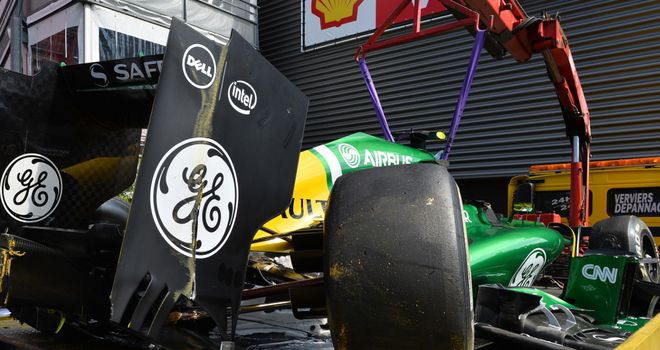 |
Crashed out: Giedo van der Garde's Caterham
|
 |
Sebastian Vettel: P1 but also suffered a puncture
|
Sebastian Vettel was fastest in second practice for the Belgian Grand Prix but also set alarm bells ringing again at Pirelli after suffering a high-speed tyre failure towards the end of the session.
Having earlier lapped the 7.004km Spa-Francorchamps track in a time of 1:49.331s, the World Champion was 11 laps into a long run when his right-rear tyre suffered a high-speed puncture.
With about 20 minutes of the session remaining, Vettel slowed through the 190mph Blanchimont corner. He returned to the pits without further incident but his session was over.
Speaking to Sky Sports F1, Red Bull Team Principal Christian Horner said it was too early to speculate as to the cause of the puncture.
"He had a puncture and the cause of which we are not sure yet, but thankfully the tyre is one piece which will let Pirelli have a good look at it and we can find out quickly what the cause was," he said.
The puncture naturally raised fears that the high-speed Spa track might produce a repeat of the degrading scenes witnessed at the British GP earlier this summer.
Horner agreed that track debris might have been the cause rather than the intense loadings the tyres are placed under, although it was later reported that Fernando Alonso's Ferrari had also suffered a tyre failure.
"You would have thought so, but we haven't seen any other punctures. The fact is that the tyre has come back in one piece, so Pirelli can have a good look at it," Horner added.
Pirelli introduced a new tyre at the last race in Hungary in response to the blowouts seen at Silverstone in June.
In conjunction with the FIA, they have also set more rigid limits on parameters such as tyre pressures and camber angles - even the practice of swapping a car's rear tyres - which teams push to extract performance and longevity.
Vettel's truncated session still yielded him the fastest time, with team-mate Mark Webber just 0.059s slower.
Romain Grosjean was third fastest for Lotus ahead of Ferrari's Felipe Massa and Toro Rosso's Jean-Eric Vergne.
Lotus's Kimi Raikkonen was sixth fastest with Alonso, Sergio Perez (McLaren), Nico Rosberg (McLaren) and Paul di Resta (Force India) completing the top ten.
Lewis Hamilton was 12th fastest in his Mercedes while McLaren's Jenson Button was 15th. Meanwhile, Marussia's Max Chilton was 22nd overall.
Unlike the morning's wet/dry session, the track was bathed in sunshine when cars took to the track, with times quickly starting to tumble.
Vettel was fastest on the hard tyre (1:50.555s) but Webber went over a second quicker after switching the medium about half an hour in. The German did the same soon after to set what proved the benchmark time.
With Lotus electing not to run their passive DRS system, Grosjean then moved third, with Raikkonen slotting in behind him and Perez fifth ahead of Rosberg and Hamilton.
Di Resta and Sutil soon split the Silver Arrows, which had been expected to go well on a track that demands high power. Unless, Mercedes were sandbagging, however, it seems that they have work to do heading into the weekend.
Massa, who had complained of oversteer at the start of the session, also jumped up the order, as did Vergne, whose team-mate, Red Bull hopeful Daniel Ricciardo, ended the session down in 16th.
As they moved up, the World Champions were embarking on their long runs, with Webber and Vettel again showing impressive pace, although the latter was not able to finish his run.
There was another nasty moment shortly after Vettel's puncture when Giedo van der Garde's Caterham hit the barriers at speed exiting Curve Paul Frere. However, the Dutchman was soon out of his car and appeared uninjured.
No comments:
Post a Comment